Lap steel guitar
The lap steel guitar is a type of steel guitar which is typically played with the instrument in a horizontal position on the performer's lap or otherwise supported. The performer changes pitch by pressing a metal or glass bar against the strings as opposed to a traditional guitar where the performer's fingertips press the strings against frets. The bar placed against the strings is called a "steel" or "tone bar".
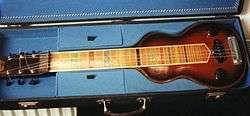 A lap steel guitar from the 1950s | |
| Classification | String instrument |
|---|---|
| Related instruments | |
There are three types of lap steel guitars:
- Acoustic lap steel guitar: The body resembles a traditional Spanish guitar. These were originally called "Hawaiian guitars", after the "slack-key" playing technique was popularized there in the late 1800s. These instruments are specifically designed to be played horizontally; i.e., the strings are higher off the fingerboard than a traditional guitar. Traditional guitars can be modified to play this way by using a "nut extender", a device to raise the strings.
- National or Dobro-type guitars, which typically have reinforced square necks and feature a large aluminum cone, called a "resonator", to increase volume.[1]
- Electric lap steel guitars: These guitars are designed to be played horizontally and feature an electric pickup so they do not require any resonant chamber. Guitars in this category may differ markedly in external appearance and include instruments made from a rectangular solid block of wood. In addition to the lap-played model, a closely related version called a "console steel guitar” often featured more than one neck which made it too heavy to be played on the performer's lap. It is supported on legs (but does not include the pedals or knee levers of the pedal steel guitar). Electric lap steels typically have six, eight or up to ten strings.
Description
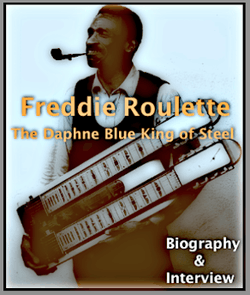
A lap steel guitar's strings are raised at both the nut and bridge ends of the fingerboard, typically to about half an inch. The strings are too high to contact the surface of the neck, so frets, if present, are only for reference and are often replaced by markers. Some lap steel guitars can be converted between lap and fretted playing, or are modified versions of conventional guitars—the only difference is usually string height. Round-necked resonator guitars set up for steel playing fall into this category.
Instruments designed exclusively as lap steel guitars typically have modified necks that make fretted playing impossible. The hollow neck acoustic lap steel, developed by Chris Knutsen and popularized by Weissenborn, extends the body cavity behind the neck all the way to the head. The square-necked resonator guitar has a strengthened square profile neck, allowing heavier string gauges and/or higher tunings that would normally be considered impossible (or certainly ill-advised) on a conventional guitar. The electric lap steel guitar typically incorporates the entire neck into the solid body of the guitar, again providing extra strength to allow a greater variety of string gauges and tunings.
Console steel guitars, typically with more than six strings and/or multiple necks, are rarely played in lap steel fashion (without their legs), but are often referred to as lap steel guitars by many makers and authorities.
Playing
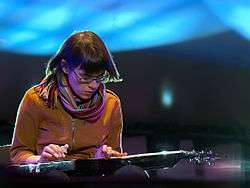
The lap steel guitar is typically placed on the player's lap, or on a stool in front of the seated player. When playing with stand-up musicians, such as in a bluegrass band, it has become an alternative for the player to also play standing up; supporting the guitar with a guitar strap around the neck, with the guitar suspended horizontally, resting against the stomach area; providing stage mobility, such as for mic accessibility for singing. Unlike a conventional guitar, the strings are not pressed to a fret when sounding a note; rather, the player holds a metal slide called steel (or tone bar) in the left hand, which is moved along the strings to change the instrument's pitch while the right hand plucks or picks the strings. This method of playing greatly restricts the number of chords available, so lap steel music often features melodies, a restricted set of harmonies (such as in blues), or another single part.
.jpg)
The steel guitar, when played in Hawaiian, country, bluegrass, or western swing styles, is almost always plucked using a plastic thumbpick affixed to the right hand's thumb, and metal or plastic "fingerpicks" fitted to the fingers of the right hand. This allows the player greater control when picking notes on non-adjacent strings. Some blues players, especially those who use a round-neck resonator guitar played upright, conventional-guitar-style, with a bottleneck or hollow metal slide on one left-hand finger, forgo the fingerpicks and thumbpicks, and use their bare fingers and thumb instead. On the other hand, a minority of blues players and many rock players use a conventional flatpick.
History
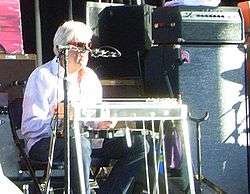
It is widely reported that the lap steel guitar was invented by a Hawaiian youth named Joseph Kekuku in 1889.[2][3][4] It is said that the 17 year-old Kekuku was walking along a railroad track and picked up a metal bolt, slid the metal along the strings of his guitar and was intrigued by the sound. He taught himself to play using this method with the back of a knife blade. Various other people have also been credited with the innovation.[5] The instrument became a major fad in the United States during the 1920s and 1930s. The instrument became especially popular in Hawaii, as musicians played in tent-rep shows.[6]
It was electrified in the early 1930s, and in 1932 the first production electric guitar was introduced, the aluminum Ro-Pat-In (later Rickenbacker) A-22 "Frying Pan" lap steel. This made the so-called "Hawaiian" guitar the first electric stringed instrument (just a few years before Les Paul and Charlie Christian modified their instruments and after the theremin was patented in 1928). The earliest documented performance with an electrically amplified guitar was in 1932, by Gage Brewer. The Wichita, Kansas-based musician had an electric Hawaiian A-25 (frypan, lap-steel) and a standard electric Spanish from George Beauchamp of Los Angeles, California. Brewer publicized his new instruments in an article in the Wichita Beacon of October 2, 1932 and through performances that month. The first electric instrument on a commercial recording was made and played in 1935 by Bob Dunn, a musician in Houston, Texas who played in the Western swing band Milton Brown and His Musical Brownies. Dunn owned a music store that bore his name in the Houston area.
The lap steel, dobro and pedal steel guitar are associated most closely with Hawaiian music, country music and bluegrass, though some players have used them in rock music, jazz, blues, and other musical genres. The round neck, metal-bodied resonator guitar is used almost exclusively by blues, rock, or blues-rock musicians. In Vietnam, these guitars are sometimes used in Nhạc tài tử, where they're referred to as the "Hạ Uy Di" (from "Hawaii").
Tunings
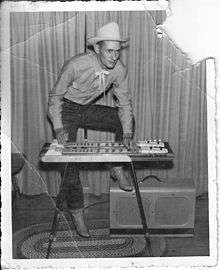
The Lap steel guitar is typically not tuned in standard guitar tuning (E–A–D–G–B–E, low to high). Rather, it is usually tuned to an open chord, often an extended chord like a 6th, 7th, or 9th. (All tunings are shown low-to-high; that is, thickest string to thinnest, or sixth string to first string).
The earliest Hawaiian lap steel tuning was open A low bass, E–A–E–A–C♯–E. Blues and rock players tend to favor one of two tuning families: open G/open A, or open D/open E. Open G is tuned D–G–D–G–B–D; open A raises each of those notes a whole tone (2 frets) to E–A–E–A–C♯–E.
During the 1920s and 1930s, much of the sheet music written for lap steel utilized open A tuning as the de facto standard tuning for the instrument. Other tunings such as E7 (B–D–E–G♯–B–E), C♯m (B–D–E–G♯–C♯–E), and many other tunings were developed.
Open D is tuned D–A–D–F♯–A–D, and open E is a whole tone higher: E–B–E–G♯–B–E. Joe Perry of Aerosmith uses open E on his electric lap steel. David Lindley is another player who uses transposed variations of these tunings.
Bluegrass and country dobro players using a square-neck instrument tend to favor an altered G tuning, often called "high-G", where the sixth string is tuned up to G instead of down to D, and the fifth string is also tuned up, to B: G–B–D–G–B–D. They also sometimes raise it up to "high-A": A–C♯–E–A–C♯–E. These are examples of tunings possible on a lap steel that could cause serious damage if attempted on a round-neck resonator or standard guitar.
Henry Kaleialoha Allen in his book[7] uses a modified C6 tuning, with a B♭ in the bass: B♭–E–G–A–C–E. Jerry Byrd has a C6 variant with C♯ in the bass: C♯–E–G–A–C–E.
Dobro players also generally use a set of strings with different gauges than those used on standard electric or acoustic guitars to help them to project more sound and to achieve their higher tunings.
Many western swing lap steel players, and some old-time country lap steel players, use a C6 tuning. There is no "standard" C6 tuning; one popular one is C–E–G–A–C–E. This tuning is a good one for learning Don Helms' lap steel melodies from old Hank Williams records, although Helms used a lap steel with legs (a "console steel"), with two necks having eight strings each; Helms actually used an E13 tuning, which adds the 7th (D) and the 13th (C♯) to the E tuning, making it B–D–E–G♯–B–C♯–E–G♯, low to high. An extended C6/Fmaj7 is used by western swing pedal steel guitarists on their ten-string pedal steels. This tuning, C–F–A–C–E–G–A–C–E–G, is difficult to achieve on the six-string steel but a subset thereof is achieved as previously mentioned. A6 is a commonly used alternate for C6 and was used by greats such as Billy Hew Len, Leon McAuliffe, and Herb Remington.
The E7 tuning is used by many players, especially those who begin learning with the Mel Bay Steel Guitar Method instructional books. The E7 tuning in those books is spelled either B–D–E–G♯–B–E or with the 6th string lowered to the tonic E: E–D–E–G♯–B–E. Note the similarity of this second tuning to the open E tuning above: the only difference is the fifth string, which is lowered from the tonic E to the 7th note in the key of E, which is D.
There are many other tunings used by players. Pedal steel guitarists switching over to lap steel often bring over a modified version of the ten-string E9 tuning that is the standard for country pedal steel; pedal steels, and a few non-pedal "console steels" actually have multiple necks, each in a different tuning, and very often on a pedal steel the 2 main necks will be in E9 and C6 tunings. As noted under the C6 tuning, an A6 tuning is also used.
See the links below for a list of additional tunings.
Manufacturers
- Asher Guitars & Lap Steels
- Breedlove Guitar Company
- Cole Clark
- Duesenberg
- Dobro (a registered trademark of Gibson Guitar Corporation)
- Eastwood
- Ellis Guitars
- Epiphone
- Electromuse
- Fender
- Framus, Germany
- Gibson (also under Kalamazoo, Mastertone, and Recording King brands)
- Gretsch
- Harmony
- Höfner
- Jolana
- Jupiter Creek, Australia
- National String Instrument Corporation
- Peavey Electronics (makers of the Peavey Powerslide)
- Regal
- Rickenbacker
- Silvertone
- Valco (under brands such as Supro, Dwight, and National)
- Weissenborn (also under Gold Tone)
Notable players
- Eddie Alkire
- Dan Auerbach
- Toy Caldwell
- Mike Auldridge
- Jeff "Skunk" Baxter
- Vishwa Mohan Bhatt
- Debashish Bhattacharya
- Junior Brown
- Bob Brozman[8]
- Jeff Buckley
- John Butler
- Jerry Byrd
- Buddy Cage
- Larry Campbell
- Glenn Ross Campbell
- Cindy Cashdollar
- Nels Cline
- BJ Cole
- AJ Ghent
- Jerry Douglas
- The Edge
- Buddy Emmons[9]
- John Fahey
- Santo & Johnny
- Don Felder
- John Fogerty
- Paul Franklin
- Sunil Ganguly
- Jerry Garcia
- David Gilmour
- Ken Greer
- Christoph Hahn
- Martin Harley
- Ben Harper
- George Harrison
- Jeff Healey
- Don Helms
- Daniel Ho
- Sol Hoʻopiʻi
- Steve Howe [10]
- Rob Ickes
- Alain Johannes
- Orville Johnson
- Brian Jones
- John Paul Jones
- Brij Bhushan Kabra
- Ben Keith
- Steve Kimock
- Kaki King
- Sneaky Pete Kleinow
- Jeff Lang
- Daniel Lanois
- Julius Lamperez
- John Lennon
- David Lindley
- Megan Lovell
- Barbara Mandrell
- Harry Manx
- Paul McCartney
- Mike Mogis
- King Ben Nawahi
- Ángel Parra
- Al Perkins
- Herb Pedersen
- Kelly Joe Phelps
- Robert Randolph
- Red Rhodes
- Sonny Rhodes
- Jack Rose
- Gerald Ross
- Freddie Roulette
- Xavier Rudd
- Andy Sannella
- Travis Stever
- Troy Van Leeuwen
- Clarence White
- Ron Wood
- Oscar "Buddy" Woods
- Rusty Young
- Watermelon Slim
See also
- Chitra veena
- Electromuse
- Lap slide guitar
- Lap steel ukulele
- Pedal steel guitar
- Steel guitar
- Table steel guitar
- Vichitra veena
References
- Phillips, Stacy (2016). The Art of Hawaiian Steel Guitar. Pacific, MO: Mel Bay. p. 4. Retrieved December 8, 2017.
- "Hawaiian Steel Guitar Association". HSGA. Archived from the original on 2018-03-16. Retrieved 2015-12-24.
- "Masterfully Hand Crafting Guitars in California Since 1982 – Asher Guitars & Lap Steels Store". Asherguitars.com. Retrieved 2015-12-24.
- "Lap steel guitars". Weissenborn.es. Archived from the original on 2016-03-04. Retrieved 2015-12-24.
- "Brad's Page of Steel". Well.com. Retrieved 2015-12-24.
- Bill C. Malone. Country Music, U.S.A.: Second Revised Edition. Books.google.com. p. 127. Retrieved 2015-12-24.
- How to Play the Hawaiian Steel Guitar (Mutual Publishing, 2008, ISBN 1-56647-864-2)
- "Bob Brozman". Discogs.com. Retrieved 31 August 2017.
- "Buddy Emmons". Discogs.com. Retrieved 31 August 2017.
- "Ask YES - Friday 21st June 2013 - Steve Howe - Yesworld". Yesworld.com. Retrieved 31 August 2017.
External links
| Wikimedia Commons has media related to Lap steel guitars. |
- Hawaiian Steel Guitar Association – An organization which promotes the development of lap steel guitar with worldwide membership.